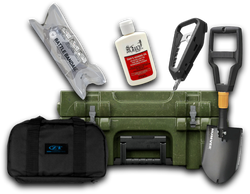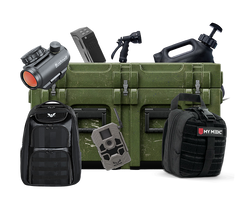Understanding the M4 Carbine: Is the M4 Carbine Automatic?
Table of Contents
- Introduction
- The Historical Evolution of the M4 Carbine
- Specifications of the M4 Carbine
- Is the M4 Carbine Automatic?
- Real-World Applications and Operational Effectiveness
- Conclusion
- FAQ
The M4 carbine has become a staple in modern military engagements, serving as the backbone of infantry units in various combat scenarios. But a common question arises among enthusiasts and novices alike: Is the M4 carbine automatic? This inquiry delves deeper into the M4's design, functionality, and military application, providing clarity for those eager to understand one of the most iconic firearms of our time.
Introduction
Imagine a soldier in the heat of battle, maneuvering through a complex environment, relying on their weapon not just for defense but as an extension of their tactical capabilities. The M4 carbine, with its lightweight design and versatile functionality, has earned its place in the hands of military personnel around the globe. But what truly sets the M4 apart from other firearms? Is it merely a semi-automatic rifle, or does it possess capabilities that allow for automatic fire?
This blog post aims to unravel the complexities surrounding the M4 carbine, exploring its history, design, and operational characteristics. By the end of this post, readers will have a thorough understanding of what the M4 carbine is, the various configurations it offers, and the implications of its automatic capabilities. We will also highlight how Crate Club supports tactical enthusiasts with high-quality gear and tools, ensuring they are always prepared.
The post will cover the following aspects:
- The historical evolution of the M4 carbine
- Detailed specifications of the M4 and its variants
- An in-depth look at the M4's firing modes
- Real-world applications and operational effectiveness
- Insights into the tactical community and preparedness gear
Join us as we explore the M4 carbine and its critical role in modern warfare, shedding light on the nuances that define this remarkable firearm.
The Historical Evolution of the M4 Carbine
The M4 carbine's roots trace back to the U.S. military's quest for a more compact and versatile weapon system that could replace the longer M16 rifle. Developed in the 1980s, the M4 was designed to meet the evolving demands of close-quarters combat. Here’s a brief overview of its historical context:
Development Timeline
-
Origins: The M4 carbine was developed by Colt in response to a 1982 U.S. Army request for a carbine variant of the M16A2. It was officially adopted by the military in 1994.
-
Initial Configuration: The original M4 featured a 14.5-inch barrel and was designed for semi-automatic and three-round burst firing modes. This design aimed to improve maneuverability in tight spaces, crucial for urban warfare.
-
M4A1 Upgrade: By 1994, the M4A1 variant was introduced, which featured a fully automatic firing mode rather than a burst function, improving its effectiveness in combat scenarios.
-
Operational Use: The M4 saw extensive action during the War on Terror, quickly becoming the primary infantry weapon for U.S. forces in Iraq and Afghanistan.
-
Ongoing Modifications: Over the years, the M4 has been subject to numerous upgrades and modifications, enhancing its reliability, accuracy, and versatility. These upgrades have included the adoption of improved optics, suppressors, and modular attachments that allow for customized configurations.
Global Adoption
Today, the M4 carbine is not only used by the U.S. military but has been adopted by over 60 countries worldwide. Its modularity and effectiveness have made it a preferred choice for various military and law enforcement agencies, showcasing its versatility in different operational environments.
Specifications of the M4 Carbine
Understanding the M4 carbine's specifications is crucial to appreciating its design and functionality. Here are some key features:
Design and Construction
- Caliber: The M4 fires the 5.56×45mm NATO cartridge, known for its lightweight and high-velocity characteristics.
- Operating System: The M4 utilizes a gas-operated, direct impingement system, allowing for quick cycling of the action.
- Weight: The M4 weighs approximately 6.4 pounds (without magazine or accessories), making it lightweight and easy to maneuver.
- Barrel Length: The standard M4 features a 14.5-inch barrel optimized for close-quarters engagement while maintaining effective range.
- Magazine Capacity: It is typically fed from a 30-round STANAG magazine, with compatibility for various capacities.
Firing Modes
The M4 carbine's versatility is exemplified in its firing modes, which include:
- Semi-Automatic: The shooter fires one round per trigger pull, allowing for greater control and accuracy, especially at longer ranges.
- Burst Fire (M4): The original M4 featured a three-round burst mode, designed to conserve ammunition while providing a rapid response during engagements.
- Fully Automatic (M4A1): The M4A1 variant allows for continuous fire as long as the trigger is held down, providing a suppressive fire capability critical in intense combat situations.
Is the M4 Carbine Automatic?
To answer the central question, Is the M4 carbine automatic?—it depends on the variant in question. The base M4 model is capable of semi-automatic and three-round burst fire, while the M4A1 is the fully automatic version. Here's a breakdown of the implications of these firing modes:
Automatic Capabilities Explained
-
M4 (Base Model): The M4's three-round burst function was initially intended to improve accuracy and conserve ammunition. However, it has been criticized for its mechanical complexity and limited effectiveness in high-stress situations.
-
M4A1: The M4A1's fully automatic capability enables soldiers to engage multiple targets quickly, making it suitable for dynamic combat environments. The automatic mode allows for more flexibility in suppressive fire scenarios, essential for infantry operations.
Legal Considerations
It’s important to note that while the M4A1 is an automatic firearm, civilians in the United States cannot legally own fully automatic weapons manufactured after May 19, 1986, due to restrictions imposed by the National Firearms Act. This means that civilian versions of the M4 are typically semi-automatic.
Real-World Applications and Operational Effectiveness
The M4 carbine has proven itself in various operational theaters, demonstrating versatility and effectiveness in combat. Below are some insights into its real-world applications:
Combat Scenarios
-
Urban Warfare: The M4's compact size and lightweight design make it ideal for urban environments where maneuverability is crucial. Soldiers can navigate tight spaces effectively, making quick adjustments and engagements in close quarters.
-
Versatility in Configuration: The M4's modular design allows soldiers to adapt their weapons for specific missions. With accessories such as suppressors, optics, and foregrips, troops can customize their setups to meet mission requirements.
-
Reliability: Despite early criticisms regarding reliability, modern iterations of the M4 have improved significantly, with the M4A1 capable of firing over 1,600 rounds between stoppages, making it a dependable choice for military personnel.
Tactical Community Insights
As a member of the tactical community, having high-quality gear is paramount. At Crate Club, we understand the importance of preparedness. Our subscription service offers tactical enthusiasts a curated selection of gear tailored to enhance their skills and readiness. Whether you are a seasoned veteran or new to the tactical world, our monthly crates provide essential tools, survival equipment, and EDC gear designed to empower you in any situation.
Explore our subscription options:
- Lieutenant Tier: $49.99/month, average value $89. Perfect for newcomers to tactical gear.
- Captain Tier: $99.99/month, average value $153. The right mix of survival and tactical gear for everyday use.
- Major Tier: $199.99/month, average value $305. Ideal for experienced survivalists seeking premium gear.
- General Tier: $399.99/quarterly, average value $561. Real-issue tactical gear used by professionals.
Discover more about our offerings: Crate Club Subscription Services.
Conclusion
The M4 carbine stands as a testament to modern military innovation, balancing firepower and versatility in a compact design. Understanding its capabilities—especially its automatic firing options—provides insight into why it has become a preferred choice for military and tactical professionals worldwide. Whether in the hands of seasoned soldiers or tactical enthusiasts, the M4 carbine’s design and functionality continue to evolve, ensuring its place in the arsenal of modern warfare.
Embracing preparedness is essential for anyone involved in tactical operations. At Crate Club, we are committed to providing the best gear and resources to help you enhance your skills and stay ready for any challenge. Join our community today and equip yourself with the tools you need to succeed.
FAQ
Is the M4 carbine fully automatic?
The M4A1 variant of the M4 carbine is fully automatic, while the original M4 has a three-round burst function.
Can civilians own an M4 carbine?
Civilians can own semi-automatic versions of the M4, but fully automatic versions are restricted under U.S. law.
What caliber does the M4 carbine use?
The M4 carbine is chambered for the 5.56×45mm NATO cartridge.
How does the M4 compare to the M16?
The M4 is a shorter, lighter variant of the M16, designed for close-quarters combat, whereas the M16 is longer and typically used in traditional infantry roles.
What accessories are commonly used with the M4?
Common accessories for the M4 include optics, suppressors, forward grips, and various rail-mounted devices for enhanced performance.
For those looking to enhance their tactical skills and preparedness, explore our Crate Club Shop for high-quality gear and equipment tailored to your needs.
Comparte este artículo



